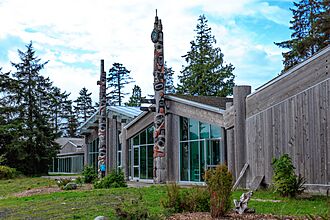Haida Heritage Centre facts for kids
Quick facts for kids Haida Heritage Centre |
|
|---|---|

Haida Heritage Centre at Kay Llnagaay
|
|
| General information | |
| Location | Second Beach Road, Skidegate, British Columbia, Canada |
| Coordinates | 53°14′53″N 131°59′59″W / 53.2481°N 131.9998°W |
| Completed | July 1, 2007 (soft opening) |
| Opening | August 23, 2008 |
| Cost | $19.2 million (total projected cost) |
| Technical details | |
| Floor area | 4,800 m2 (52,000 sq ft) |
| Design and construction | |
| Architect | David Nairne & Associates Ltd. |
The Haida Heritage Centre is a special place that celebrates the culture and history of the Haida people. It is located in Skidegate, a community on Graham Island. This island is part of Haida Gwaii, off the coast of British Columbia, Canada. The Centre is built near an old village site called Kay Llnagaay. This name means "Town of Sea Lions."
The Centre is owned and managed by Gwaalagaa Naay. This group is part of the Skidegate Band Council. It is a popular place for visitors to learn about Haida culture. Many people describe it as a place where the Haida people can share their stories. The Centre also works with schools and universities. They offer educational programs for students of all ages.
The Haida Heritage Centre has many different areas. These include a museum, a gift shop, and a small restaurant. There is also a Performing House and a Canoe House. You can find a Carving Shed and the Bill Reid Teaching Centre here too.
How the Centre Began
Planning for the Haida Heritage Centre started in the early 1990s. In 1995, a group called the Qay’llnagaay Heritage Centre Society was formed. They helped make the plans a reality.
Many different groups worked together on this project. These included the Heritage Centre Society and the Skidegate Band Council. Parks Canada also helped with the planning. Funding came from various sources. These included government groups and the Gwaii Trust Fund. The Haida Gwaii Museum Society also contributed.
The Centre was planned to be finished by mid-2005. However, it actually opened to the public on July 1, 2007. This was a "soft opening." The Grand Opening Ceremonies happened on August 23, 2008. During this event, three new canoes were launched. These were the first canoes made in Skidegate since 1985. Two famous canoes, Loo Taas and Loo-plex, also joined the celebration.
What You Can See and Do
The Haida Heritage Centre was designed by David Nairne and Associates Ltd. It looks like a group of traditional Haida longhouses. This design helps visitors feel like they are in an old Haida village. The Centre has five large buildings made of cedar wood. They are connected by a central area.
One of the most striking features is the six Haida totem poles. These poles represent six different villages of Skidegate. Each pole was carved by a different artist. They were put up in 2001.
Inside the Centre, you will find several important spaces:
- Welcome House (Stlaay Daw Naay): This is where visitors first arrive.
- The Carving House (Gyaa K'id Naay): This is a large, open building. Local artists work here on big projects. They carve monumental poles and canoes.
- The Canoe House (Skaajang Naay): This area shows how the Haida people used canoes. It explains how they traveled, gathered food, and traded. It is home to Bill Reid’s 50-foot cedar canoe, Loo Taas. There is also a full-size replica called Loo-plex. Both canoes are used for special events and races. Artists also work here making paddles and bentwood boxes.
- Performance House (Gina Guu Aahliuu Naay): This is a theater that can hold up to 250 people. It is designed like a traditional Haida longhouse.
- Bill Reid Teaching Centre (Aahl Sgwaansing Naay): This center has studios and classrooms. Young Haida artists learn their skills here. They are taught by master carvers and designers. Special training and university courses are also offered.
Haida Gwaii Museum
The Queen Charlotte Islands Museum Society started in 1973. Their goal was to create a museum for the islands. The museum first opened in 1976. It collects artifacts, old records, and information about the Haida people. It also gathers items related to European settlement on the islands. The museum's collection includes items from 1890 to today. Most pieces are from between 1900 and 1990.
The museum was made bigger when the Haida Heritage Centre was built. It is now an important part of the Centre. The museum's exhibits are set up in time order. They show Haida history from before European contact. They also cover the time of contact and modern Haida life.
The galleries display many pieces of Haida art and culture. You can see button blankets, argillite carvings, and totem poles. The museum also teaches about the natural history of the islands. It features information about the Gwaii Haanas National Park Reserve and Haida Heritage Site. There is also a special gallery for art shows throughout the year. Many totem poles are on display, both old and new.
In August 2022, the Haida Gwaii Museum received some very special Haida artifacts. A museum in the UK returned these items. They included an argillite tray and an argillite sculpture.

